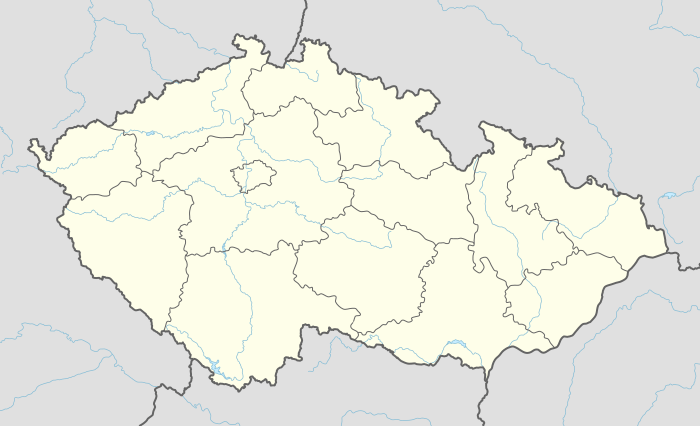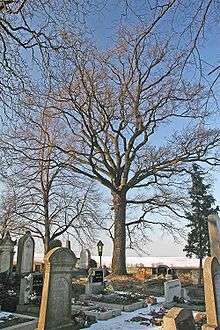Libenice
Libenice (German:Libenitz) is a village and municipality in Kolín District in the Central Bohemian Region of the Czech Republic.
Libenice | |
|---|---|
Municipality and village | |
 Coat of arms | |
 Libenice Location of Libenice in the Czech Republic  Libenice Libenice (Europe) | |
| Coordinates: 49.984°N 15.258°E | |
| Country | |
| Region | Central Bohemian Region |
| District | Kolín District |
| Elevation | 725 ft (221 m) |
| Time zone | UTC+1 (CET) |
| • Summer (DST) | UTC+2 (CEST) |


Geography
Libenice is located on the Hořanský potok brook on the Kutná Hora Plateau (Kuttenberger Hochfläche). State road I/38 runs north of the village between Kutná Hora and Kolín. The streams Kaňk and Sukov rise to the south-east, the Velký Kuklík and the Malý Kuklík to the south.
Neighboring towns are Tři Dvory on the north, Starý Kolín and Mladý Hlízov on the northeast, Skalka, Hlízov and Turkaňk on the east, Kaňk on the southeast, Grunta on the south, Hořany, Čertovka and Dolany on the southwest, Červené Pečky and Nebovidy on the west and Polý Důlůl and Šťáralka on the northwest.
History
Archaeological finds show that the area was populated by Celtic people during the Hallstatt and La Tène periods. At the Celtic settlement site between Libenice and Kaňk in 1981 numerous ceramic finds from the 5th – 1st Century BC were discovered. One of the most important finds is a smelting furnace with 10 kg of slag from the 2nd – 1st Century BC with traces of pyrrhotine, chalcopyrite, sphalerite and copper, which also testify to early underground mining on the Kaňk. In 1959, an elongated area north of the village was discovered with the grave of a 50-year-old woman buried with plenty of bronze jewelry and a two-meter long stone stele made of yellowish and ocher-colored mica migmatite with tourmaline, which probably indicates a Celtic sanctuary; recent findings in archeology tend to point to a rectangular earthwork. In 1993 roughly ten graves from the Celtic period were found near this site by grave robbers.
The first written mention of the village and manor of Ljubenice was in 1142 as the possession of the Sedletz (Sedlec u Kutne Hory) Cistercian monastery. In the middle of the 13th century, the mining settlement of Grunta was created in the territory of Libenice. In 1396 the monastery sold the Libenice estate to King Wenceslaus IV of Bohemia for his lifetime. In 1422, King Sigismund pledged the property to the Erkinger von Seinsheim. The subsequent pawn owners of the Libenice estate with the villages Bylany, Dolany and Všestáry were Hanuš from Rychnov from 1437, and Hynek and Pavel from Zaloňov from 1440 to 1454. In 1498 King Vladislaus II of Hungary mortgaged Libenice to Bohuš Kostka von Postupitz, and in 1499 to Jan Janovský from Soutice, then to Jan von Práchňany, and in 1505 to Václav and Bohuslav Lorecký von Lkouš. In 1524 Katharina von Lichtenburg bought the estate, in 1530 it was inherited by Johann Trčka the elder from Lípa. The latter sold the Libenice castle together with the villages of Libenice, Dolany, and Grunta in 1538 to Václav Popel from Vesec from Suchdol. In 1540 the Kuttenberg patrician Jindřich Smíškový from Vrchoviště bought the manor and lands of Libenice, including the village of Grunta. He took his seat at Libenice castle and called himself Libenický von Vrchoviště. After Jindřich Libenický was killed in 1540 in Kuttenberg by Jan Firšice von Nabdín his son Beneš Libenický inherited the estate in 1550, then 1553 it fell to his second-son Jan Libenický. In 1560 Jan Libenický bought the claims of the Sedletz monastery for the castle and the village of Libenice, the village of Grunta with the patronage of the church, and the village of Dolany for 100 thalers. In 1567 Jan Libenický bought the villages of Němčice and Ohaře. Two years later, he made a settlement with the Kolín Council over the creation of a waterway between his pond near Starý Kolín and the Libenický district. In 1580 he acquired the Hrobský mlýn in Kolín and a little later the Jeníkov estate. Jan Libenický from Vrchoviště was married to Anna Kamejská from Lstiboř and had two sons and two daughters; he died in 1589 and was buried in the church of Grunta. The brothers Vilém Všebor and Vratislav Libenický from Vrchoviště jointly took over the paternal dominions of Libenice and Jeníkov; they paid off their mother's share of the estate through a settlement of 1,000 schock Bohemian groschen, the mill in Kolín, annual income from 50 schock Bohemian groschen, and a large farm in Dolany with furniture and cattle. In 1591 Vilém Všebor died without descendants.
In the same year King Rudolf II acquired Kolín and showed interest in the Libenice manor. In 1593 he redeemed the pledge for 7,500 thalers to Vratislav Libenický, which had existed since 1437, and with the villages of Libenice, Grunta and Dolany the estate passed to Kolín. At the same time, he also acquired the villages of Němčice and Ohaře from Vratislav Libenický, which thus also became part of his private estate. At that time, the village of Libenice consisted of the castle, five farmers, ten Chlaupners and five Posedeken. In 1611, the new King Matthias II gave the reign of Kolín Wenzel Graf Kinsky out of gratitude for the support in the overthrow of his brother Rudolf II. Not included was Libenice, which Matthias II wrote to his captain Martin Wilhein von Wustenow. After Wenceslaus Graf Kinsky fell out of favor with the king, Matthias II bought the Libenice estate back in 1616 and reunited it with the Kolín rulers. In the period after the Battle of White Mountain, the Kuttenberg Jesuits took over the care of the branch church in Grunta. In 1628, Libenice was annexed to Podiebrad, together with Kolín. In 1634 a fire caused by workmen and miners from Gang destroyed the fortress with the barn and three chalets.
The tax roll from 1654 lists five peasants, ten Chalupners including the lordly Kretschmers, and five cottagers. In 1713 the village consisted of five potažníci, ten chalupners, and five cottagers. In the 1730s, non-Catholics met with foreign clerics in the area for secret services and heretical suppers. The Libenický rybník pond was drained in 1749 and converted into meadowland because it yielded only little and caused continuous damage to the properties of the residents by flooding. In 1762 the Church of the Virgin Mary in Grunta became the branch church of the parish of Gang. In the course of the "raabisation", the Libenice farm was closed in 1778 and its fields were parceled out.
On the basis of the Patent of Toleration of 1781, the majority of the residents professed to the Protestant Helvetic Confession. Since the number of parishioners was too small to form their own parish, they were assigned to the Helvetian pastorate in Močovice, and the Protestant services were conducted by preachers from surrounding parishes in private houses in Libenice and Dolany. In 1786 there were 54 houses in Libenice. In 1801 a one-class school for children from Libenice, Grunta, Čertovka, Dolany and Malá Vysoká was opened in Libenice; the lessons had been started beforehand. After the formation of a Protestant parish in 1826, a church was built, which was consecrated in September 1827. The Protestant rectory was completed in 1839. The two-class instruction was started in 1842.
In 1843, the "Rustic and Dominican village of Libenitz" in the Kauřim district consisted of 67 houses and 486 people, including 31 Protestant and a Jewish family. In the village there was a school, an inn and a Protestant church with a rectory. The one-story inn "Skalka" was registered in Libenitz. The Catholic parish was Gang, part of the town of Kutná Hora, the governmental center was Kaisersdorf (Císařoves). In 1846 the Evangelical cemetery was created with financial support from the Gustav Adolf Foundation. Until the middle of the 19th century, Libenitz remained subject to Kolin.
After the abolition of patrimonial rule, Libenice, together with the district of Grunta, formed a municipality in the district of Kolin from 1849. During this time, the Catholic residents of the villages of Grunta, Čertovka, Dolany, Hořany and Libenice unsuccessfully applied several times for the re-establishment of the church in Grunta and the establishment of a Catholic parish. In 1863 a Protestant private school for the reformed children from Libenice, Čertovka, Dolany, Hořany and Vysoká was started, in the public school from that time on there was again single-class instruction. From 1868 the village bwas part of the Kolin district. In 1869 Libenice had 487 inhabitants and consisted of 72 houses. The Protestant private school received the right to conduct public instruction in 1876. Between 1884 and 1885 the public school building was repaired and enlarged; afterwards the pupils of both schools were taught together, partly also in the Protestant school. From the school year 1892/93 two classes were formed again, in 1896 the school was renovated again. The Catholic parish of Grunta was built in 1900. In 1900 608 people lived in Libenice, in 1910 there were 582. In 1919 the district road to Kutná Hora was built as a gravel road, it was only paved in 1966. The Protestant school was closed in 1921 due to insufficient number of students. In 1930 Libenice had 547 inhabitants and consisted of 106 houses. During the German occupation of the Protectorate of Bohemia and Moravia, the paratroopers Rudolf Pernický and Leopold Musil landed at Libenice instead of Hlinsko on December 21, 1944 due to incorrect calculation of the take-off location. In 1965 the village school also stopped teaching. In 1986 asteroid (4823) Libenice was named after the municipality. At the beginning of 1992, Grunta separated from Libenice and formed its own community. In the 2001 census, 260 people lived in the 114 houses in Libenice. The municipality has had a coat of arms and banner since 2018; the golden unicorn comes from the coat of arms of the Libenický von Vrchoviště.
Historic sites
- Menhir in the village square is a replica of the stele found in the sanctuary
- Libenice castle: A fortress probably originated at the end of the 14th century. In 1574, Jan Libenický of Vrchoviště had the fortifications rebuilt by the Kuttenberg master builder Gabriel. The fortress burned out in 1634 and was last mentioned in 1646. The three-winged building was then used as an outbuilding.
- Evangelical church, built in 1826-1827 on the western outskirts, near the church is the evangelical cemetery created in 1849
- Former Protestant private school, it was built between May and October 1863 on the basis of the Protestant patent and became a public school in 1876. It was closed in 1921.
- Former evangelical rectory, built in 1839, today it is rented out by the church administration as a residential building.
- Libenický dub, the approx. 200-year-old summer oak in the cemetery, is 22 m high and has a trunk circumference of 2.9 m. It is protected as a historic tree.
- Niche Chapel of the Assumption, it was built at the end of the 18th century and was restored in 2014.